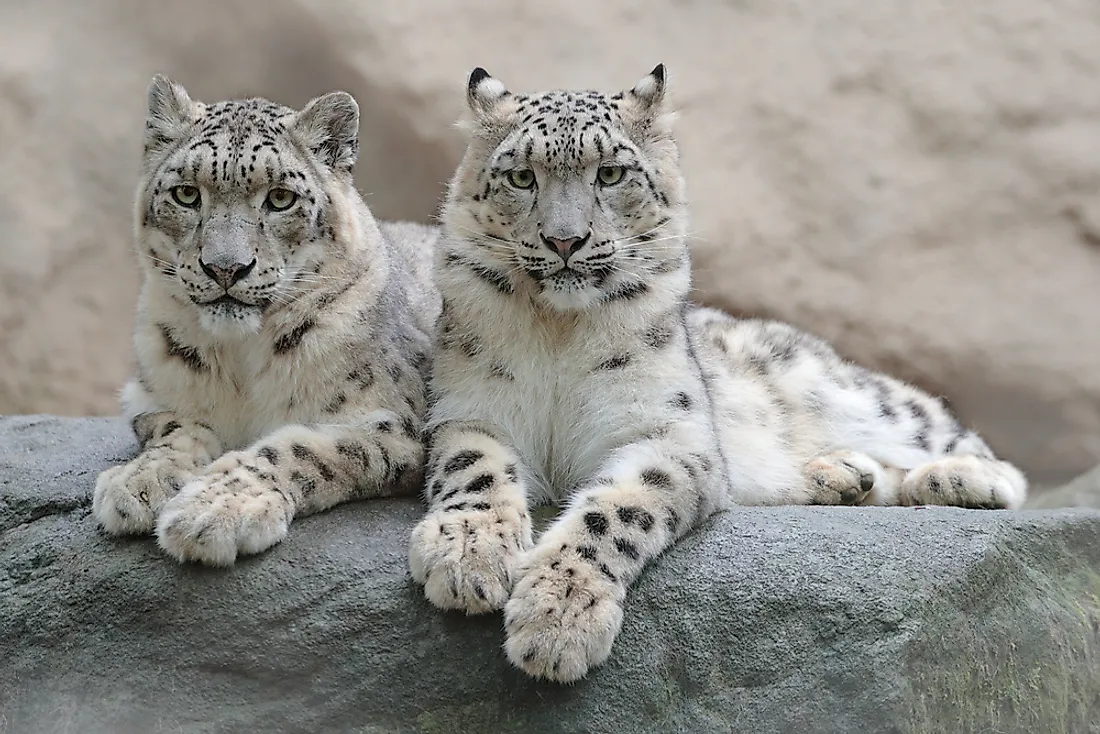Where Do Snow Leopards Live?

The snow leopard (Panthera uncia) is a large cat that is native to the mountainous regions of South and Central Asia. Living in the alpine and subalpine zones, snow leopards have evolved and adapted to some of the harshest environments on Earth. They are capable of scaling the steep slopes of mountains with agility and can blend into the landscape to avoid detection while hunting. Female snow leopards can have between one and five cubs, but usually have a litter of two or three. Snow leopard cubs are born with a thick coat of fur but are dependent on the mother until approximately 18 months old. Cubs are also born blind, but their eyes open after about one week.
Physical Description
Snow leopards typically have thick fur that is whitish-gray in color, and can even have a yellow tinge. The neck and head have solid spots, while the rest of the body has rosettes, which are larger and form a ring that encloses smaller spots. Each leopard has a unique patterns of spots, which the World Wildlife Fund (WWF) uses to identify individual snow leopards when conducting research. Snow leopards are characterized by long and bushy tails, which are used for balance, and can also be draped over their body to provide protection from the cold when sleeping. The cat species is very agile, with forelimbs that are shorter than the hind limbs, and are capable of jumping as far as 50 ft. Their paws are large and covered in fur, which which act as snowshoes, as well as providing padding when climbing on sharp rocks.
Range and Habitat
Snow leopards inhabit various regions across central and northern parts of Asia, including the Himalayas, where they live at high altitudes of up to 18,000 ft above sea level. The snow leopard is known to live in 12 countries, including Mongolia, Russia, Afghanistan, Pakistan, India, Nepal, Bhutan, and China. Snow leopards are solitary animals and they are very elusive. In fact, snow leopards are sometimes referred to as the "Ghost of the Mountains" because they are very rarely seen. There is no term used to describe a group of snow leopards because they are never observed in groups.
Diet
Snow leopards can hunt large animals with weights exceeding their own by up to three times. Their diet is mainly composed of ibex, Argali wild sheep, blue sheep, deer, pikas, marmots, and other small animals. Most animals hunted by the snow leopard are also hunted by the local indigenous populations, and as their prey dwindle, they begin to hunt livestock for survival, resulting in retaliatory killings by the local communities.
Threats and Conservation
It is estimated that between 4,080 and 6,590 snow leopards currently exist in the wild, which is a population decrease of about 20% over the past 16 years. As a result, the species is listed as "Endangered" (EN) on the International Union for Conservation of Nature's (IUCN) Red List. Some of the threats facing snow leopards include poaching, loss of habitat as a result of climate change, retaliatory killings, and reduced prey. Organizations such as the World Wildlife Fund (WWF) are working to reduce the threats faced by snow leopards, as well as reducing human-leopard conflicts. They also focus on increasing anti-poaching efforts and protecting the fragile habitat in order to increase the snow leopard's population in the wild.











